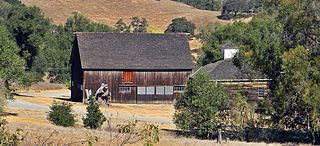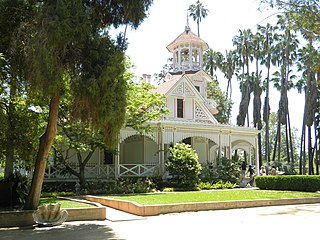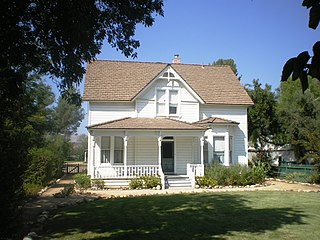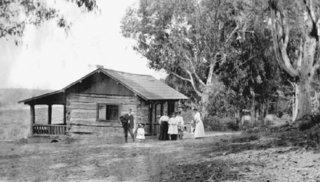
The Rancho San Andrés Castro Adobe is a historically and architecturally significant house located in the Pájaro Valley, California. The two-story Rancho San Andrés Castro Adobe is a historic rancho hacienda that was built between 1848-49.

Kentucky Camp is a ghost town and former mining camp along the Arizona Trail in Pima County, Arizona, United States, near the community of Sonoita. The Kentucky Camp Historic District is listed on the National Register of Historic Places and has been since 1995. As it is located within Coronado National Forest, the United States Forest Service is responsible for the upkeep of the remaining buildings within the Kentucky Camp Historic District.

Olompali State Historic Park is a 700-acre (2.8 km2) California State Park in Marin County, California. It is constituted of the former Rancho Olómpali and was the site of the famed Battle of Olómpali during the Bear Flag Revolt. Rancho Olómpali was purchased by the Californian government in 1977, which turned it into a public park.

The José María Alviso Adobe, located in Milpitas, California, United States, was the home of José María Alviso, an early alcalde (mayor) of neighboring Pueblo de San Jose. It was built in 1837 and enlarged in the early 1850s, and stands as an excellent example of the Monterey Colonial style of architecture popularized throughout California in the 1830s and 1840s. It is the only remaining example of this style in the Santa Clara Valley and San Francisco Bay Area. The adobe is listed on the National Register of Historic Places.

Warner's Ranch, near Warner Springs, California, was notable as a way station for large numbers of emigrants on the Southern Emigrant Trail from 1849 to 1861, as it was a stop on both the Gila River Trail and the Butterfield Overland Mail stagecoach line (1859-1861). It was also operated as a pioneering cattle ranch.

Queen Anne Cottage and Coach Barn is a Victorian style pair of buildings at Baldwin Lake, on the grounds of the Los Angeles County Arboretum and Botanic Garden, located in Arcadia and the San Gabriel Valley of southern California.

The historic Simi Adobe–Strathearn House served as the headquarters of Rancho Simi, also known as Rancho San José de Nuestra Senora de Altagracia y Simi, one of the land grants in Alta California by the Spanish government. The name derives from Shimiji, the name of the Chumash village here before the Spanish. Rancho Simi was the earliest Spanish colonial land grant within Ventura and Santa Barbara Counties. At 113,000 acres, Rancho Simi was one of the state's largest land grants.

Canelo is a ghost town in eastern Santa Cruz County, Arizona, between the Canelo Hills and the northern end of the Huachuca Mountains. The site lies along Turkey Creek on Arizona State Route 83, between Sonoita and Parker Canyon Lake, which is about ten miles (16 km) to the south-southeast in Cochise County. Today, several historic buildings listed on the National Register of Historic Places remain standing in Canelo, including a one-room schoolhouse and a United States Forest Service ranger station.
Adobe Walls is a ghost town in Hutchinson County, 17 miles (27 km) northeast of Stinnett, in the U.S. state of Texas. It was established in 1843 as a trading post for buffalo hunters and local Native American trade in the vicinity of the Canadian River. It later became a ranching community. Historically, Adobe Walls is the site of two decisive battles between Native Americans and settlers. In November 1864 First Battle of Adobe Walls, Native Americans successfully repelled attacking troops led by Kit Carson. Ten years later, on June 27, 1874, known as the Second Battle of Adobe Walls, civilians at the Adobe Walls trading post successfully fought off an attack by a war party of mainly Comanche and Cheyenne warriors led by the Comanche chief Quanah Parker. The second battle led to a military campaign which resulted in Indian relocation to Indian Territory.

Canelo Ranger Station, also known as Canelo Work Station, is a historic ranger station in the Coronado National Forest, within Santa Cruz County of southern Arizona. It is located in the ghost town of Canelo, within a small valley between the Canelo Hills on the west and the northern Huachuca Mountains on the east.

The Ojo Caliente Hot Springs Round Barn is in Ojo Caliente, New Mexico and was built in 1924. It is the only adobe round barn in the United States.

The Edward L. Jones House is a historic house at 5555 North Casa Blanca Drive in Paradise Valley, Arizona. It is a 2-acre (0.81 ha) property including a two-story adobe house, an adobe pump house, and an adobe and wood-frame barn. Built in 1932, the main house is a good example of Pueblo and Monterrey adobe revival styles, with walls of colored stucco and a multicolor tile roof. The roof eaves show exposed viga beams, and the windows are wooden casements, with wrought iron railings.

Eagar Townsite Historic District is a section of the town of Eagar, Arizona which has been designated a National Historic Place. Sitting on roughly 54 acres, the site contains 37 structures, 21 of which have historical significance. The period of significance is from 1886, the year the townsite was founded, through 1942, which represents the significant period of development of the town. The site was added to the Register on July 23, 1993.
The Thornton Adobe Barn near Isabel, Kansas was built in 1942. It is a Gambrel roofed adobe dairy barn. It was listed on the National Register of Historic Places in 2003.
The San Juan Historic District in San Juan, New Mexico is a 23 acres (9.3 ha) historic district which was listed on the National Register of Historic Places in 1988. The listing included 14 contributing buildings and two non-contributing buildings.
The Milne-Bush Ranch, on Rt. 1 in or near Roswell, New Mexico, was listed on the National Register of Historic Places in 1988. The listing included two contributing buildings. It has also been known as Ave de Paso.
The Casados House, in Rio Arriba County, New Mexico near Los Ojos, New Mexico, was built in 1885. It was listed on the National Register of Historic Places in 1985.

The L. C. Ranch Headquarters, in Gila, New Mexico, was built mostly in 1890 and was listed on the National Register of Historic Places in 1978.

Murphy's Barn, also known as the Murphy Barn/Powers Studio, is a historic building that was built in 1846, by Matthew M. Murphey in Carmel-by-the-Sea, California. The structure is recognized as an important American period farm building and the oldest remaining artist's studio in Carmel. It was nominated by the Carmel City Council as a historical building and an application was submitted to the California Register of Historical Resources on July 1, 2002.
















